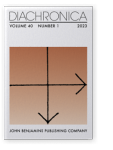Vol. 40:1 (2023) ► pp.73–110
On the origins of multiple exponence in Crow
Multiple exponence is a phenomenon in which morphemes that encode a given piece of information are realized multiple times within a single word. Unlike other members of the Siouan language family spoken across North America, Crow possesses a set of modal auxiliaries that display multiple exponence of subject person agreement. I show that one source of multiple exponence in Crow is the grammaticalization of the inflectional future from the motion verb arrive there, which brings with it its own agreement prefixes. Multiple exponence then extended to compound modals containing the inflectional future and finally to a morphologically unrelated modal – a distinct case of multiple exponence begetting additional multiple exponence. Thus, this study contributes to the broader understanding of the diachronic pathways to multiple exponence.
Article outline
- 1.Introduction
- 2.Multiple exponence in Crow
- 3.The inflectional future -ii ‘will, must’
- 4.The modal auxiliaries -iimmaachi ‘will, must’, -iih ‘may, might’, and -iishdaachi ‘should’
- 5.The involuntary desiderative -isshi ‘feel like’
- 6.Discussion
- 7.Conclusion
- Acknowledgements
- Notes
- Abbreviations
-
References
